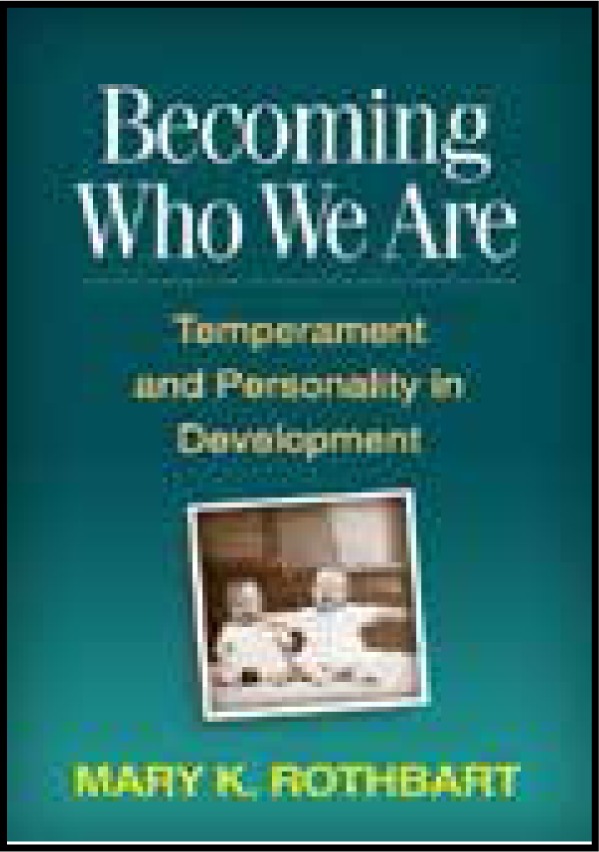
If you have been wondering what has been happening to the concept of temperament since Thomas and Chess put forward their nine temperament traits, this is the book for you. Mary Rothbart, Distinguished Professor Emerita of Psychology, has been a leader in the fields of temperament, emotional development, and attention development research for many decades. She has developed several questionnaires that are widely used in research. It is wonderful that she has written this book, as she is in a good position to pull together and organize the research in this field from the perspective of one who has worked in it, and relate it to the whole area of developmental psychology.
This book is a detailed review of the field of temperament from its historical roots to suggested future research. Its relationship to the field of personality research is discussed. It is written, in my opinion, for psychologists, especially psychology researchers, so as a child psychiatrist I felt I was sometimes looking in from the outside. I had difficulty with certain terms, such as “structures of meaning,” and had to keep returning to the definition. This is an academic book, and in parts it is quite dense and dry. There is a lot of repetition of certain concepts, so perhaps it is meant more as a reference book than to be read from cover to cover. It could easily be the textbook for a third or fourth year psychology course on temperament, with convenient summaries at the end of each chapter. I strongly recommend it for anyone starting to do research on temperament, because it reviews the field and is quite up to date.
The book begins with definitions and a history of the subject, starting in antiquity, much before Thomas and Chess. Chapter 2 is about the methodology of temperament research. Chapter 3 reviews what is known about the biology of temperament, incorporating up-to-date primate studies, genetic studies, and brain research. Chapter 4 discusses temperament in infancy. I enjoyed the first four chapters, which I felt were quite accessible to physicians interested in the topic. Thomas and Chess’s nine temperament dimensions are discussed, but other dimensions have been developed since then, and it is these newer dimensions, especially the ones developed by Dr. Rothbart, that form the foundation for most of the analysis and discussion that follows in the book. Dr. Rothbart also compares her dimensions to those of other current models.
Rothbart’s temperament dimensions are: “non-aggressive negative affect (fear and sadness),” “aggressive negative affect (frustration and social anger),” “effortful control (activation and attentional control),” “extraversion/surgency (sociability, high-intensity pleasure, and positive affect),” “orienting sensitivity (general and affective perceptual sensitivity and associative sensitivity),” and “affiliation (emotional empathy and empathetic guilt).”
Although the next four chapters have titles which imply clearly delimited and differentiated topics, the material in the chapters seems broader in scope. They summarize a vast area of research in most or all areas of child psychology that could be said to have any bearing on temperament. The above dimensions are discussed in terms of development of meaning, coping, culture, conscience, and other areas, with a lot of overlap in the material. These chapters are dry, with terminology perhaps more familiar to research psychologists, especially the chapter “The Self and Structures of Meaning.” In that chapter are included the terms (from various sources) “state self,” “experiential self,” “agentic self,” “sensorimotor self,” “body or object self,” “constructed self,” “narrative self,” “looking-glass self,” “inner private self,” “idealized self,” and others. How temperament is affected by and affects interpersonal relationships is discussed, which is relevant to family therapists in particular.
The last three chapters are more clinical. The end of chapter 9 introduces research on training attention and educating children, parents, and teachers about temperament. I recommend reading the original research here, which is easy because there are ample references. Throughout most of the book, I was not sure where the line is being drawn between normal temperamental types and psychopathology, such as ADHD and Major Depression. One of the articles cited concerning training attention did not include children with ADHD, but the dimension called “Effortful Control” is very relevant for ADHD. Chapter 10 brings in the topic of psychopathology and its relationship to the field of temperament. There is still a lot of repetition of earlier concepts, so perhaps one could read this chapter without having read everything that came before and still learn about the connection between temperament and psychopathology.
This is an important book. It demonstrates how much the field has developed since Thomas and Chess brought temperament to the attention of clinicians. Old categories have been tested, and some have not survived, whereas others were refined and defined with more precision. How different temperament dimensions develop over the life cycle and stability over time of different dimensions is discussed in great depth. The reference list is extensive, just as one would expect of a book of this nature.


